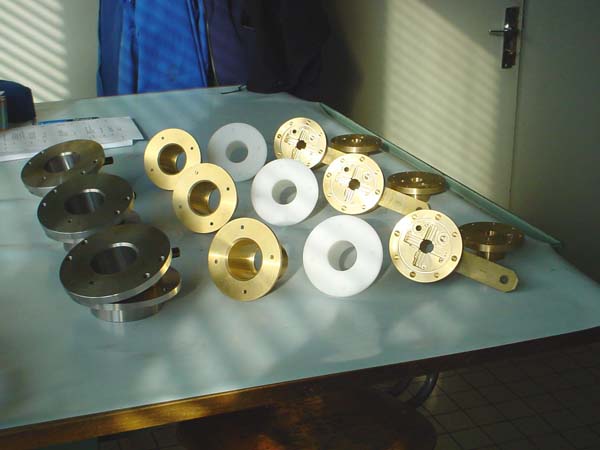De nombreux réacteurs ont été conçus par le laboratoire et ont été, ou sont encore utilisés sur les fours solaires MWSF et MSSFs.
MEDIASE
MEDIASE (Moyen d’Essai et de DIagnostic en Ambiance Spatiale Extrême, Test and Diagnostic Facility under Extreme Space Environment) is a stainless steel chamber for the MWSF’s focus equipped with a hemispherical silica glass window, a water-cooled front shield surrounding a water-cooled sample holder.
The material specimen, up to 90 mm wide and 2 to 4 mm thick, is heated by the solar energy concentrated at the focus of the solar furnace, under high vacuum or any controlled atmosphere.
On the back face of the sample, a water-cooled shield protects the instruments from the irradiance energy of the sample, and also shields it from radiative exchange with the surroundings.
Several measurements are possible, under solar heating alone, or combined with ion and/or UV irradiation, by adding an ion source capable of delivering up to 1021 ions m-2 s -1 under 5 keV and/or a UV source.
The THEMIS solar tower offers two experimental areas:
– Temperature, using a two-colour optical fiber pyrometer or a pyro-reflectometer,
– total (0.6 to 40 um) or spectral directional (0 to 80°) emittance, using a total radiometer through a window and a 3-mirror goniometer, these measurements leading to the total or spectral directional emissivity of the material,
– quantitative mass loss, using a quartz crystal micro-balance (under vacuum only),
– qualitative mass-loss, by measuring the neutral and/or ionised residual and emitted species from the material with an open source mass spectrometer (under vacuum only).
MEDIASE has been used to heat samples up to 2500 K under a residual pressure from 10-7 hPa (cold sample) to 5 10-5 hPa (sample at 2400 K).
MESOX
MESOX, (Moyen d’Essai Solaire d’OXydation, Oxidation Solar Test Facility), allows to heat samples up to 2500 K at pressures between 102 and 105 Pa, under the 6 kW MSSF concentrated solar radiation and electromagnetic microwave stress. This reactor, originally developed for oxidation studies, has been adapted to allow atoms recombination measurements on low catalytic surfaces. Atmospheric re-entry conditions may be partially simulated, and unlike studies performed in wind tunnels or in arc-jets, the pressure and the temperature may be imposed independently with a high accuracy. This chamber is placed at the focus of the 6 kW MSSF equipped with a variable shutter offering a peak heat flux density from zero up to about 4500 kW/m2. The experimental reactor consists of a silica tube, 50 cm long and 5 cm in diameter with CaF2 view ports on both end for pyrometric measurements. This reactor crosses the refrigerated microwave guide and contains a 25 mm wide by 3 mm thick sample placed on a sample-holder in stagnation point condition at the centre of the plasma volume. The microwave generator is operated at a power between 0 and 1200 W at a frequency of 2450 MHz. A pressure regulator, a gauge and a vacuum pump are used to precisely control the total pressure during the experiment. The temperature measurements on the front and back faces of the sample are performed using a single optical solar blind pyrometer with one rotating mirror and a system of two stationary mirrors. In situ diagnostics (concentration and temperature profiles) may be performed in the plasma discharge above the sample by optical emission spectroscopy.
DISCO
DISCO is an original experimental device devoted to the determination of thermo-optical properties: true temperature, reflectivity and emissivity at high temperature up to 1500°C. It is associated with a 2 kW horizontal axis MSSF for the heating of the sample. An optical fibres probe is moved alternatively in front of the sample and of a reflectivity reference located in the same plane. The emitting and detecting modules of the instrument have two functions: illumination of the instrumented surface using lasers diodes linked with optical fibres, and detection of the emitted and reflected light fluxes using photodiodes associated with monochromatic optical filters and optical fibres. A computer records the measured signals and analyses them to determine the temperature of the sample and its directional reflectivities. An additional optical fibres probe enables to control the in-situ condition (fibres faces pollution, flux losses, ?) of the optical fibres probe used for the measurement.
ROCSOL
ROCSOL is a solar reactor for the study of the melting and freezing behaviour of materials up to 3000°C under oxidizing atmosphere. It is associated to a 2 kW horizontal axis solar furnace. The incident solar heat flux on the parabola may be regulated by means of a primary shutter on the path of the parallel solar beams between the heliostat and the concentrator to control the duration of the freezing plateau. A rotating cylindrical reactor is located at the focus of the concentrator. The cell containing the material is a water-cooled rotating cavity (diameter 0.03 m, length 0.04 m) with an aperture of 0.014 m in diameter. The melting of the material occurs in a self crucible insuring high purity treatment. The concentrated solar flux can be quickly switched off by a water-cooled shutter located on a fast-moving mechanism. This movable shutter have been designed to eliminate completely the solar heat flux in less than 0.1 second. The temperature of the material is measured by optical pyrometers located behind the parabola and focused at normal incidence through the aperture of the reactor inside the sample cavity.
GINOSOL
GINOSOL is a small-scale reactor for the synthesis of carbon nano-materials using concentrated solar energy. The experimental chamber is adjusted at the focal point of a vertical 2 kW MSSF. The stand part, surrounded by the Pyrex balloon flask, is a water-cooled brass cylinder supporting the cellulose filter to collect the soot. The target is a graphite rod, or a graphite crucible filled in with a mixture of powdered graphite and catalyst promoters. It is hung in a graphite pipe linked to the filter with a brass holder. This pipe, which channels the carbon vapour and which is heated at its top by sunlight, works like a thermal screen and also forms the annealing zone. The flow rate of the buffer gas (Ar or He) is controlled by a vacuum pump, valves and a flow meter. The working pressure is adjusted by a pressure regulator. The temperature of the sample may be measured using an optical pyrometer.
TYSOL
ToySol chamber: multipurpose chamber in controlled atmosphere.
Characteristics:
– 1,5 or 2 m vertical axis MSSF
– controlled atmosphere including vaccum – 6 l chamber volume
– watercooled sample holder
– max sample size: 25 mm
– 2 side ports DN40
– 1 top port for e.g. optical measurements, window 50 mm.
WATERCOOLED MELTING SUPPORTS
Watercooled melting supports are used to hold any sample to be heated under air and the thermal gradient between the water-cooled plate and the solar heating.
Characteristics:
– 1,5 or 2 m vertical axis MSSF, 6 kW MSSF
water-cooled
– 1 support generation I with aluminium top plate: 70 mm ; depth 10 mm
– 1 support generation II with aluminium top plate: 80 mm ; depth 1.5 mm
– 1 support generation III with aluminium top plate: 75 mm ; depth 2 mm
– 1 support generation III with stainless steel top plate: 75 mm ; depth 2 mm
MOVING CHAMBER – MONO AXE
Moving chamber: controlled atmosphere 2-axis moving chamber. It has been used for example for solar melting of steel plates or for coating of materials by melting powders placed at the surface of the samples.
Characteristics:
– 1,5 or 2m vertical axis MSSF
– controlled atmosphere including vacuum
– watercooled platform for sample up to 100 mm
– fused sillica window
– X-Y steppers : currently 1 axis available for movement at controlled speed.
– Arduino based integrated controller.
NANOSOL
NANOSOL is a set of solar reactors for the preparation of inorganic nanophases by a vapo-condensation process. The solar reactors are made with glass vessels connected to vacuum pumping systems. The target (compacted powder, sintered or melted material) is placed at the focus of a vertical 2 kW MSSF on a water-cooled holder, insuring non-polluting heating. A primary vacuum or a neutral, reducing or oxidizing atmosphere can be maintained dynamically. The smokes, produced by the vaporization or the sublimation of the targets, are collected by a metallic filter placed inside the collector (glass tube) or by a water cooled brass tube (cold finger), depending on the vapour pressure of the materials. The usual production rate of nanophases is from 10 mg/day to 20mg/hour. The following nanophases are currently prepared : pure ZnO, ZnO + x%mol Bi203 (x = 0.18, 0.26, 0.88, 1.76, 3.55), ZnO + x%mol In203 (x=0, 1.5, 2.5, 5.0), ZnO + x%mol Sb203 (x=0, 1.5, 2.5, 5.0), ZnO + x%mol Co0 (x = 5, 10), Zn and Al metallic nano-particles, yttria doped zirconia, gadolinium doped ceria nanophases, etc. Material characterization by XRD, HREM, SEM, ? of the as-prepared powders, after thermal treatments, or after preparation of massive nano-materials, permits to study several properties: luminescence, catalicity and photo-dissociation properties (pure, In or Sb-doped ZnO nanophases), magnetic properties (Co doped ZnO nanophases), electrical properties (Bi doped ZnO, yttria doped zirconia, gadolinium doped ceria nano-materials), etc. Some potential applications of the nano phases are : varistors, luminescent screens, transparent electrodes, spintronics, photo-degradation of organic molecules, H2(g) production by reduction of water, solid electrolytes with high ionic conductivities, etc.
Characteristics:
– 1,5 or 2m vertical axis MSSF
– controlled atmosphere including vaccum – watercooled sample holder
– max sample size: Φ 40 mm
– watercooled filter of the pumped gas
– 2 sets

